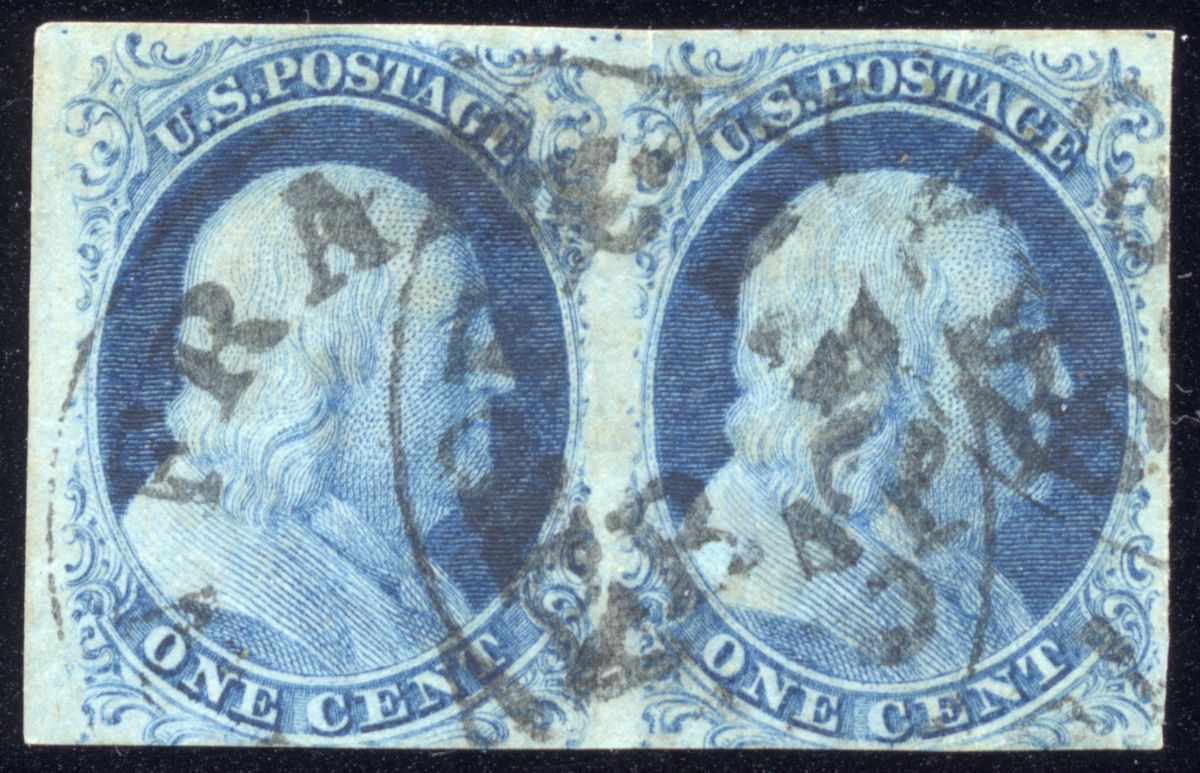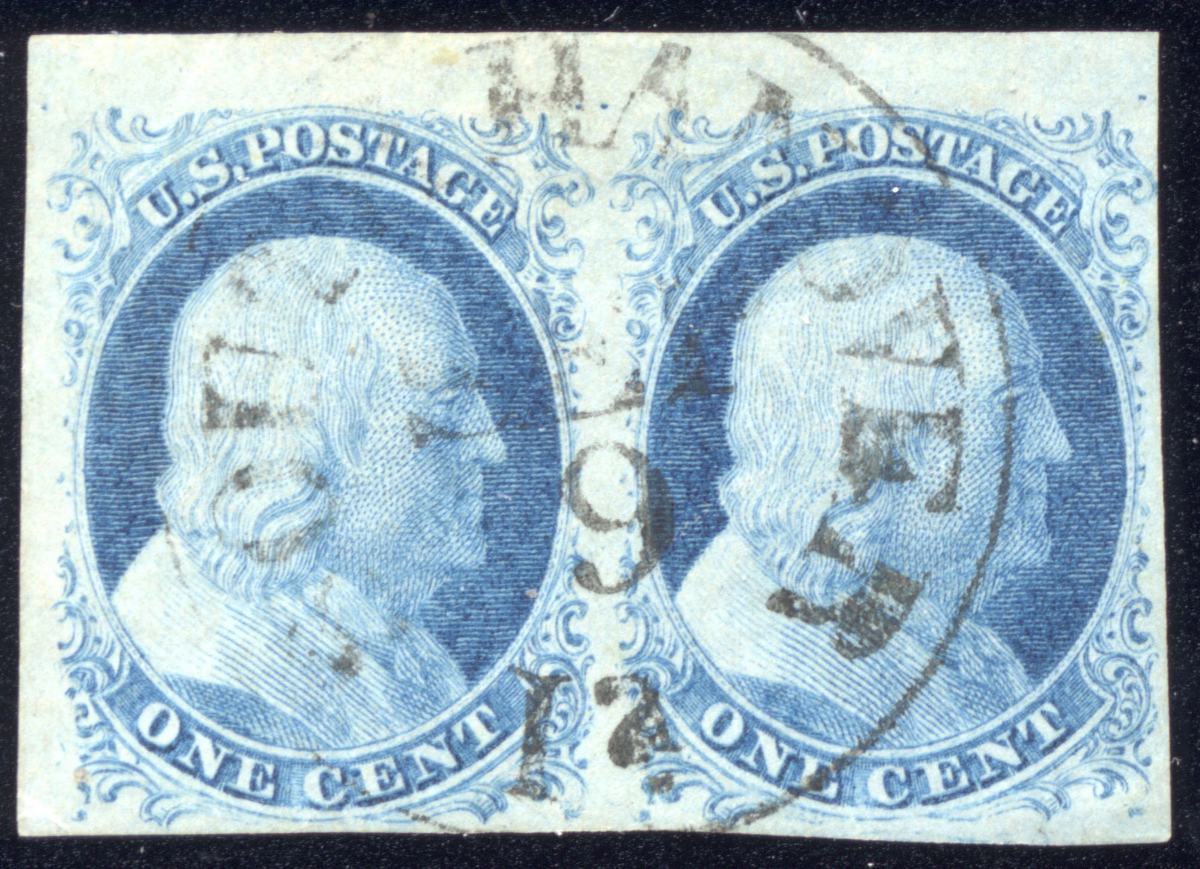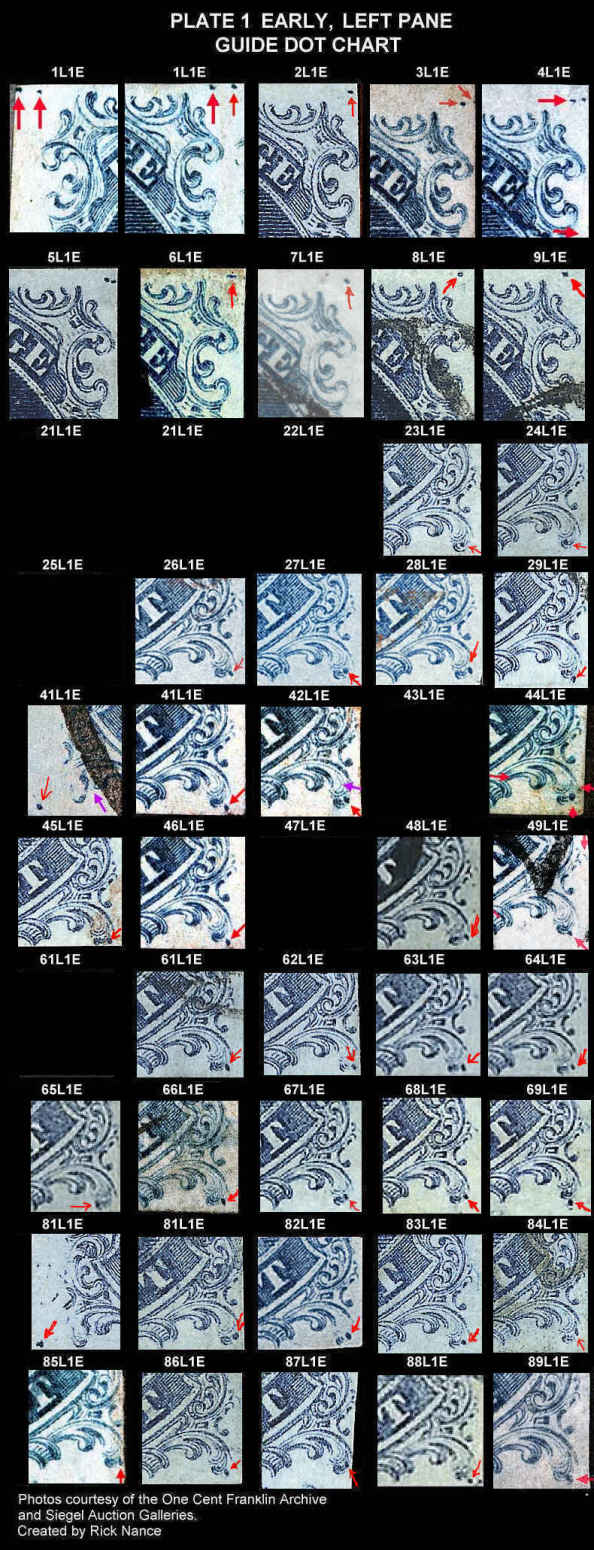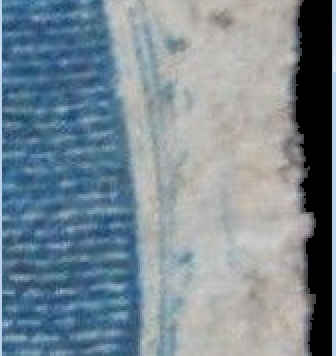| Author |
 Replies: 183 / Views: 22,320 Replies: 183 / Views: 22,320 |
|
|
|
Pillar Of The Community
United States
3073 Posts |
|
|
For general reference here are two scans, each of positions 1-2L1E. Note how the color changed over time, and how the plate wore. The April scan, which is darker blue, is 1852, and is approaching the dark blue shade, but not quite there. The Sep scan, is clearly 1852 (or later if the stamps were set aside for years), as this is an example of a very late 1E printing, showing significant wear on the plate which was apparently not hardened.   |
Send note to Staff 
|
|
|
Pillar Of The Community
United States
1223 Posts |
|
|
Thanks for the update and the quick fix for the plate dot charts, txstamp. I would appreciate it if you look it over to see if I fixed it correctly. I would also like a moderator to remove the Left Pane Chart photo in previous post so only the latest is available. Here is the updated Plate 1 Early, Left Pane Guide Dot Chart:  ps: Sorry it took so long to get it fixed.  |
Send note to Staff 
|
| Edited by jaxom100 - 01/19/2018 9:26 pm |
|
|
Pillar Of The Community
United States
1223 Posts |
|
|
Pillar Of The Community
United States
1223 Posts |
|
|
The only good plating mark that I have found so far is the line on the right side. There are 10 stamps on plate 1 early that has a similar mark according the Nienken drawings. They are 37L1E, 39L1E, 55L1E, 75L1E, 77L1E, 78L1E, 33R1E, 39R1E, 56R1E, 76R1E. My main suspect is 55L1E .....????  |
Send note to Staff 
|
| Edited by jaxom100 - 01/21/2018 8:19 pm |
|
|
Pillar Of The Community
United States
1223 Posts |
|
|
I wonder how many people would recut this stamp? Should it just be left alone?
Type 7 or type 8A? |
Send note to Staff 
|
|
|
Pillar Of The Community
United States
3073 Posts |
|
|
My eyes seem to go out of focus at the top of your stamp, so I'm not sure if its broken or not.
By recut, do you mean take scissors and straighten it out??
I hope not, but I'm assuming that's what you are asking.
I see something on this stamp, that reminds me of a stamp I used to have - and this anecdote may help you with your answer.
I had a #9 that had 4 very rough margins. For quite awhile I didn't pay much attention to it. Then one day, I was critically studying it, and I was fairly sure, for a brief moment, that it was a roulette separation. Some sort of private perforation. Some time later, I was having a nice chat with a good friend, who was an expert on private perforations. It was late in the evening, after the show had closed, and we were planning world domination and various other things -- when I thought to show him this item. We had been previously laughing a bit about some not legitimate private perforation items previously, so when I showed him yet another item ... he/we kind of quickly dis-regarded it as no way it could be. So I sold that as a #9 with my collection. Now it resides in a prominent collection, correctly described as privately perforated and so on. Worth 10x what I sold it for no doubt.
In general, I'm not a big fan of chopping up stamps. In this, there is a bit of a pizza-cutter effect on parts of your stamp. Maybe it is -- probably it isn't, but hey, who knows. When you irreparably alter an item in that manner, you lose something. Maybe nothing of value .. then again ... maybe... |
Send note to Staff 
|
|
|
Valued Member
United States
72 Posts |
|
|
Pillar Of The Community
United States
3073 Posts |
|
|
I assume there is a question coming with that last image post.
Its a bad scan, but sure looks like a #7 Ty II, B relief. |
Send note to Staff 
|
|
|
Valued Member
United States
72 Posts |
|
|
Thanks txstamp, As you can see all I have is whats on the original auction page (* Scott 7) so any other info is great, there is no gum, NH and says above average example on the receipt from 1984. |
Send note to Staff 
|
|
|
Pillar Of The Community
United States
1223 Posts |
|
|
I would be suspicious of the no gum. My first thought would be a used stamp with the postmark removed. I see so many with a "lightened" postmark that I would bet that they were successful on removing some of the inks on that series. There was a lot of that going on at that time. I would need some trace of gum to prove that it is unused. |
Send note to Staff 
|
|
|
Valued Member
United States
72 Posts |
|
|
Pillar Of The Community
United States
1223 Posts |
|
|
I have a question......
What makes a type IIIa a type IIIa? Visual ID or plate position?
I spotted a pair of Franklins from a local dealer from plate 1E that is cut right at top lines so it is hard to tell type. They are being sold as a type II. I have plated it as a type II and Type IIIa pair. It appears to be an early printing as it is heavy impression. Any idea what the value would be?
|
Send note to Staff 
|
| Edited by jaxom100 - 01/25/2018 9:15 pm |
|
|
Pillar Of The Community
United States
988 Posts |
|
|
If your plating is correct and it is a known IIIa position, it is still IIIa even if can't see break in top due to tight upper margin.
Thus known plate position always trumps other factors. However some positions are hybrids especially IIIa/III so without visualizing breaks due to poor margins, I defer to the less expensive type.
I have been critical of PSE and PF for not plating every stamp for identification of type. They have made mistakes because they cut corners and don't try to plate each stamp in many cases, especially with older certs (they want more $ to plate). But in some cases identification requires plating, not just visualization, especially if margins are tight. |
Send note to Staff 
|
| Edited by rgstamp - 01/25/2018 9:39 pm |
|
|
Pillar Of The Community
United States
1223 Posts |
|
|
Well, Neinken shows the stamp in question as a type IIIa. Franklin Archive says it is a type II but their copy has no top at all. Who is correct? I could see the start of the break as indicated by Neinken. Just not sure if it is worth what he is asking. The other of the two stamps is not on the plating archive.
Oh, BTW, I am sure of the plating. Both stamps have marks indicated by Neinken.
|
Send note to Staff 
|
| Edited by jaxom100 - 01/25/2018 9:42 pm |
|
|
Pillar Of The Community
United States
1223 Posts |
|
|
I checked around at Siegel's for similar pairs and found quite a few but the pricing was all over the place. Most were from plate 4 so I ignored those. Not a lot of pairs from plate 1E though. |
Send note to Staff 
|
|
 Replies: 183 / Views: 22,320 Replies: 183 / Views: 22,320 |
|
